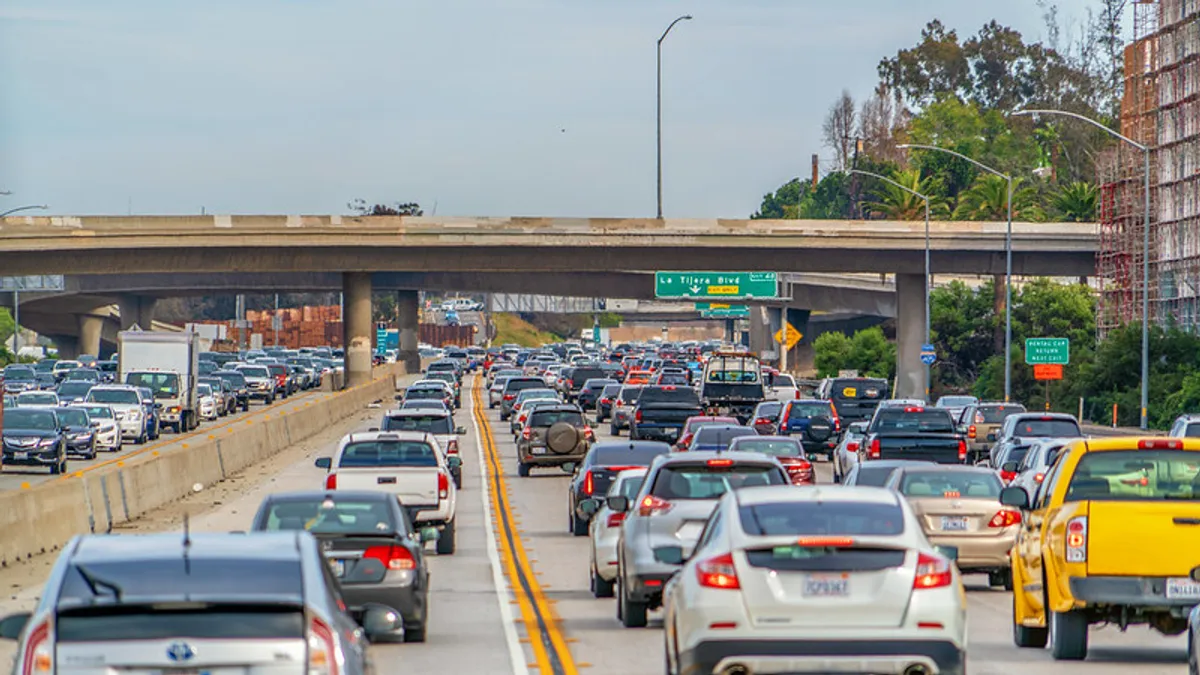Dive Brief:
- Local governments could receive grant money to support programs that cut congestion under a section of House Democrats' Investing in a New Vision for the Environment and Surface Transportation in America (INVEST in America) Act, introduced last week.
- The surface transportation bill would introduce a $250 million grant program administered by the U.S. Secretary of Transportation. Applicants would compete to fund projects that look to "reduce traffic congestion and related adverse impacts" through the use of intelligent transportation systems; real-time information; traffic management; multimodal payment systems; employer-based programs like car- and van-pool; or projects that provide other transportation options like bike or pedestrian initiatives.
- Those eligible to apply include cities with a population of 1 million or more, metropolitan planning organizations, regional entities or a state that partners with such an entity. The bill text says the Secretary must prioritize applicants from urban areas "that are experiencing a high degree of recurrent transportation congestion." Any federal grant awarded can be no more than 60% of the entire project’s cost, with projects awarded at least $10 million and at most $50 million.
Dive Insight:
As coronavirus recovery continues, some are worried traffic congestion will only intensify as people opt for single-occupany vehicles over public transit due to fears of continued COVID-19 transmission.
Leaders on the House Committee on Transportation and Infrastructure said the time is now to address congestion. Subcommittee on Highways and Transit Chair Eleanor Holmes Norton, D-DC, said on a recent press call that previous bills like the soon-to-expire Fixing America’s Surface Transportation (FAST) Act, had few specific provisions on gridlock and allowed the problem to fester.
"[Congestion] seems to have been accepted as a way of life in our past bills, but at the moment it looks as though states find that essentially you're not moving, and they're trying their own various ways to move more quickly," Holmes Norton said.
State and local governments are experimenting with their own policies and initiatives to curb gridlock, including congestion pricing, which has been popular internationally and is making headway in the U.S. City leaders have also called for greater investments in transit to provide people with more transportation options, and have criticized federal leaders for not thinking creatively enough in finding new ways to help people get around.
During the conference call, full committee Chair Peter DeFazio, D-OR, said the bill looks to reduce congestion by ramping up investment in transit to bring it to a state of good repair and then expanding service, in addition to bolstering funds for Complete Streets projects to enhance multimodal safety.
"This is just one aspect, but we wanted to particularly emphasize it with a dedicated program for new and innovative technologies dealing with gridlock," DeFazio said. "The costs of gridlock... it's a phenomenal number in terms of lost time and lost economic activity."
Experts said this provision and the numerous other grant programs inserted in the bill suggest a shift from the previous decade, which saw a consolidation and reduction of federal grant programs. This bill could create at least 17 new programs — and resurrect one regarding safe routes to school, which was killed in 2012, according to Eno Center for Transportation Senior Fellow Jeff Davis.
"We're going back to the mindset of a program for every problem, which in the last decade we tried to move on from," Davis said.
The emphasis on cities, however, has drawn opposition from committee Republicans, who say they were not consulted sufficiently in the bill’s drafting and derided it as "partisan." In a joint statement, Republican committee and subcommittee leaders criticized the bill's "outsized funding increases for urban areas," which they said "will leave rural America even further behind."
Whether this grant program — or any — makes it into the final transportation reauthorization package remains to be seen. DeFazio and Davis both noted there will almost certainly need to be a conference committee between any bills passed by the House and Senate, where some initiatives may be struck down in a bid to find compromise and assure final passage.












